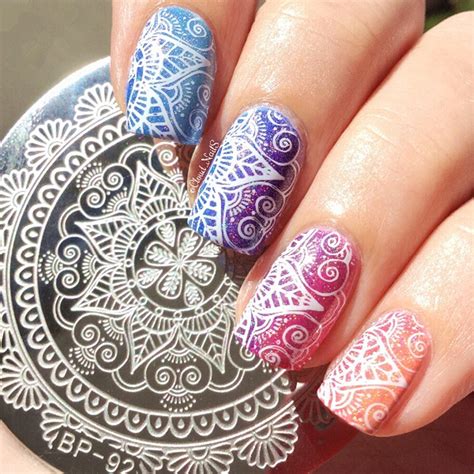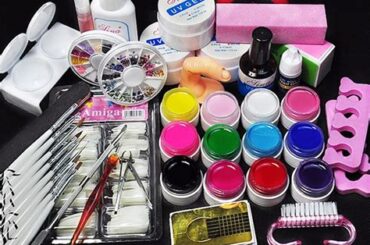Get expert tips on choosing stamping plates, prepping nails, selecting polish, mastering technique, troubleshooting issues, and incorporating stamping into nail art. Perfect your stamping game!
Choosing the Right Stamping Plates
When it comes to nail stamping, the right stamping plates can make all the difference in achieving flawless designs. With a wide array of options available in the market, it can be overwhelming to choose the best ones for your nail art. Before purchasing any stamping plates, it’s important to consider factors such as the size of your nails, your preferred design styles, and the quality of the plates.
First and foremost, consider the size of your nails when selecting stamping plates. If you have longer nails, you’ll need larger plates to accommodate the nail bed area. On the other hand, if you have shorter nails, smaller plates may be more suitable. It’s essential to ensure that the size of the design on the plate matches the size of your nails to achieve the best results.
Additionally, take into account your preferred design styles. Stamping plates come in various designs, ranging from intricate patterns to simple geometric shapes. If you enjoy creating detailed and elaborate nail art, opt for plates with intricate designs. Conversely, if you prefer minimalist nail designs, choose plates with simpler patterns that align with your aesthetic preferences.
Prepping Your Nails for Stamping
Before diving into the exciting world of nail stamping, it’s important to properly prepare your nails to ensure the best possible results. The first step in prepping your nails for stamping is to start with clean, dry nails. This means removing any old polish and thoroughly washing your hands to remove any oils and residue that may be lingering on your nail bed.
Once your nails are clean and dry, it’s time to shape and buff them to create a smooth and even surface for stamping. Use a nail file to shape your nails to your desired length and shape, and then gently buff the surface of each nail to remove any ridges or imperfections. This will create a clean canvas for your stamping designs to adhere to, and will help to prevent any unwanted smudges or smears.
Finally, before moving on to the stamping process, it’s essential to apply a base coat to your nails. Not only will this help your stamping polish adhere better to your nails, but it will also provide an extra layer of protection to help prevent chipping and peeling. Allow the base coat to dry completely before moving on to the next step in your nail stamping journey.
Selecting the Best Stamping Polish
When it comes to nail stamping, choosing the right stamping polish is crucial for achieving flawless and vibrant designs. The polish you select should be highly pigmented to ensure that the intricate details of the stamping plate transfer onto your nails with clarity and precision. Look for stamping polishes that are specifically formulated for nail art, as they are designed to provide the opacity and quick-drying properties needed for successful stamping.
It’s also important to consider the texture of the stamping polish. Opt for a formula that is neither too thick nor too thin, as this will ensure smooth and even application onto the stamping plate and transfer onto your nails. Additionally, choose stamping polishes with a wide range of colors to give you ample options for creating diverse and stunning nail designs.
Lastly, don’t forget to test the compatibility of your stamping polish with the stamping plates you plan to use. Some polishes may work better with certain plates, so conducting a patch test beforehand can save you time and frustration. By carefully selecting the best stamping polish for your nail art endeavors, you can elevate your manicures and unlock your creativity with ease.
Mastering the Stamping Technique
When it comes to nail stamping, mastering the technique is crucial for achieving flawless designs. The key to successful nail stamping lies in the proper preparation of the stamping plate, the use of quality stamping polish, and the precise transfer of the design onto the nail.
Before starting the stamping process, it’s important to ensure that the stamping plate is clean and free of any residue. Use a cotton ball soaked in acetone or a plate cleaner to thoroughly clean the surface of the stamping plate. This will help prevent smudging and ensure clean and precise designs.
When selecting a stamping polish, opt for formulas that are specifically designed for nail stamping. These polishes are formulated to have the right consistency and opacity to transfer designs onto the nail effectively. Additionally, make sure to work quickly when applying the polish onto the stamping plate to avoid drying out before transferring the design.
Cleaning Up Any Mistakes
One of the most frustrating parts of nail stamping is when you make a mistake. Whether you smudge the design, apply the wrong color, or accidentally stamp outside the lines, it can be disheartening. But fear not, there are ways to clean up any mistakes and salvage your manicure.
First, if you’ve smudged the design, don’t panic. Wait for the polish to dry completely, then use a small brush dipped in acetone to carefully remove the smudge. Take your time and be gentle to avoid further damage to the design. You can also use a cotton swab dipped in acetone for small smudges.
If you’ve stamped outside the lines or applied the wrong color, a small brush dipped in acetone can also help clean up these mistakes. Use a gentle, circular motion to remove any excess polish without damaging the rest of the design. Remember to take your time and keep a steady hand to avoid further mistakes.
Adding Finishing Touches with Top Coat
Once you have completed your nail stamping design, the final step is to add a top coat to seal in your artwork and give your nails a glossy finish. Applying a top coat not only protects your design from chipping and fading, but also adds shine and dimension to your nails.
When choosing a top coat for your nail stamping designs, it’s important to select one that is specifically formulated for use with nail art. Look for a quick-drying top coat that won’t smudge or smear your stamped design. You may also want to consider a high-gloss top coat to really make your design pop.
After applying the top coat, allow your nails to dry completely before going about your day. This will help ensure that your nail stamping design stays flawless for as long as possible. With the right top coat, your stamped nails will look professional and polished, giving you the perfect finishing touch for your nail art.
Exploring Different Stamping Designs
When it comes to nail stamping, the design possibilities are endless. From intricate patterns to cute nail art, exploring different stamping designs can be a fun and creative process. Whether you’re a beginner or a seasoned nail artist, trying out new stamping designs can add a fresh and unique look to your manicure.
One popular stamping design to explore is the floral pattern. This classic design can add a touch of elegance to your nails and can be customized with various colors to match any outfit or mood. Another design to consider is the geometric pattern, which can create a modern and edgy look. Experimenting with different shapes and lines can result in eye-catching and unique nail art.
Don’t be afraid to mix and match different stamping designs to create your own custom look. Layering different patterns and experimenting with placement can result in stunning and intricate designs. From minimalist to elaborate, there’s a stamping design out there for every nail artist to explore and enjoy.
Incorporating Stamping into Nail Art
When it comes to creating stunning nail art, incorporating stamping into your designs can take your manicure to the next level. Nail stamping allows you to easily transfer intricate and detailed designs onto your nails, giving you a professional-looking finish without all the fuss. Whether you’re a nail art novice or a seasoned pro, stamping can add a new dimension to your nail art repertoire.
One of the best things about incorporating stamping into your nail art is the endless design possibilities it offers. From delicate florals to geometric patterns to whimsical images, stamping plates come in a wide variety of designs, making it easy to find the perfect image for any look you can imagine. Plus, with the right stamping polish, you can create vibrant and bold designs that will make your nails stand out.
Another benefit of nail stamping is its versatility. You can use stamping to create an accent nail, add a subtle touch of design to all your nails, or even use it as the focal point of your manicure. Whether you want to create a simple and elegant look or go all out with a bold and eye-catching design, stamping can be tailored to suit your style and preferences.
Troubleshooting Common Stamping Issues
When it comes to nail stamping, there are a few common issues that can arise, but with the right tips and techniques, you can easily troubleshoot and overcome these challenges. One common issue that many people run into is smudged designs. This can happen if the stamping polish is not fully dry before applying a top coat. To avoid this, make sure to give the stamped design enough time to dry completely before adding any finishing touches. Smudging can also occur if too much pressure is applied when transferring the design onto the nail, so be gentle and use a light touch.
Another common problem that arises when nail stamping is incomplete or patchy designs. This can happen if the stamping plate is not properly cleaned or if the stamping polish is not evenly distributed on the plate. To troubleshoot this issue, make sure to clean your stamping plates thoroughly before each use and use a lint roller to remove any excess polish from the plate. Additionally, make sure to spread the polish evenly across the design on the plate to ensure a clean and complete transfer onto the nail.
Lastly, one common frustration when nail stamping is smearing or bleeding of colors. This often happens when using multiple colors on the same design or when layering different colors on top of each other. To troubleshoot this issue, make sure to wait for each layer of polish to dry completely before adding the next layer. Additionally, using a quick-dry top coat can help to seal in the design and prevent any bleeding or smearing of colors. By following these troubleshooting tips, you can achieve flawless and professional-looking nail stamping designs every time.
Frequently Asked Questions
What is nail stamping?
Nail stamping is a technique where a design is transferred onto the nails using a stamp and a special nail polish. It allows for intricate and detailed designs that can be difficult to achieve freehand.
What tools do I need for nail stamping?
You will need a stamping plate with designs, a stamper, scraper, and special stamping nail polish. A cotton pad with acetone can also be helpful for cleaning the tools between uses.
Is there a specific nail polish for stamping?
Yes, there are special stamping nail polishes that are thicker and more pigmented than regular polishes, making them easier to transfer onto the nails.
How can I ensure a flawless nail stamping design?
To ensure a flawless design, make sure to use enough polish on the stamping plate, scrape off excess polish with the scraper at a 45-degree angle, and transfer the design onto the nail quickly and straight.
Can I use any nail polish for stamping?
While some regular polishes may work for stamping, it is recommended to use polishes specifically made for nail stamping to achieve the best results.
How long does a nail stamping design last?
When done correctly and sealed with a top coat, a nail stamping design can last as long as a regular manicure, which is usually around 1-2 weeks.
Can I create my own designs for nail stamping?
Yes, you can create your own designs for nail stamping using stamping plates with customizable images or by layering different stamping designs to create unique looks.





